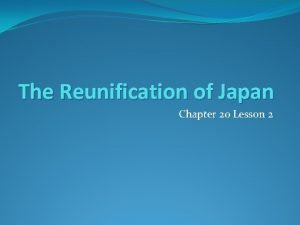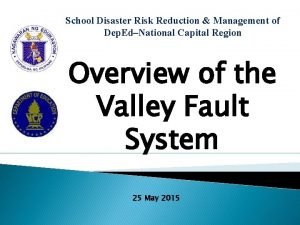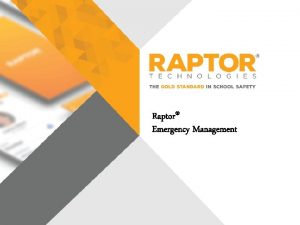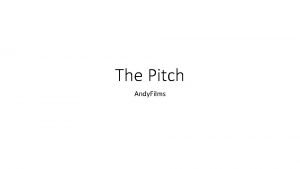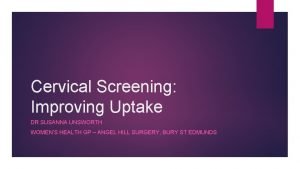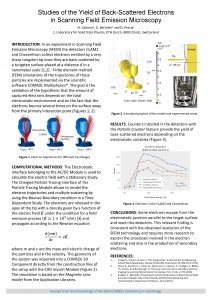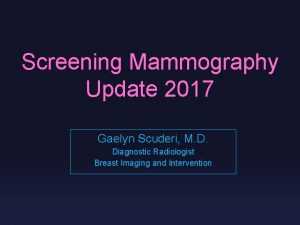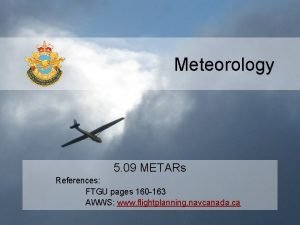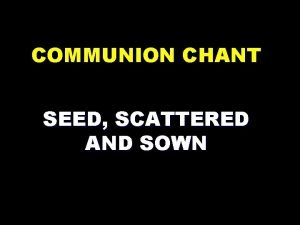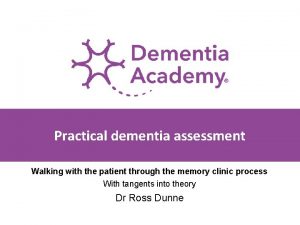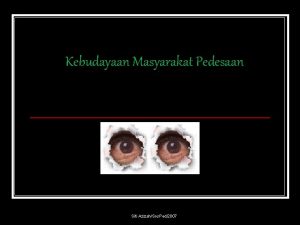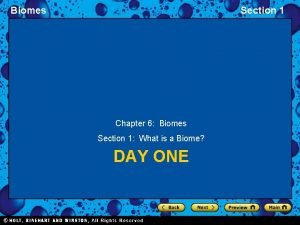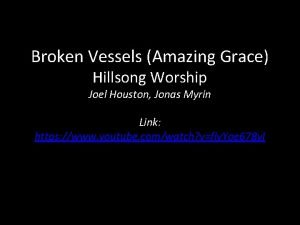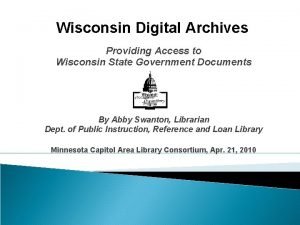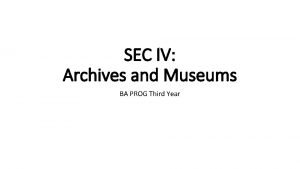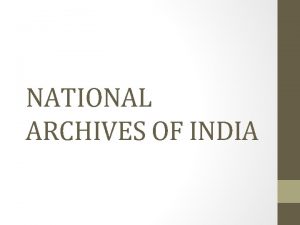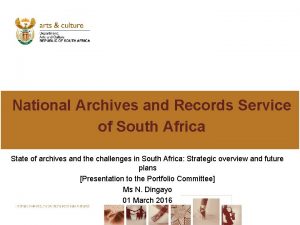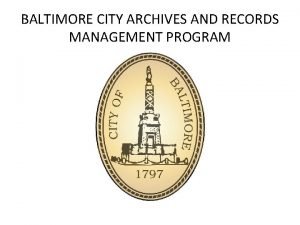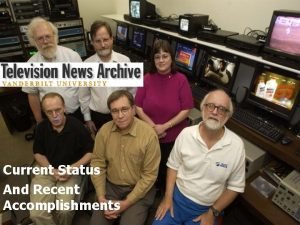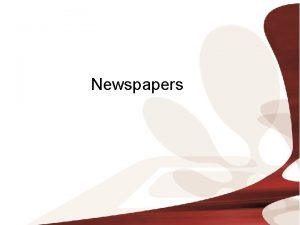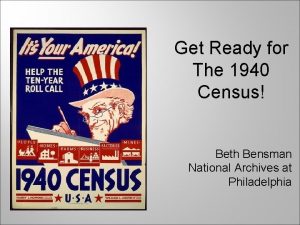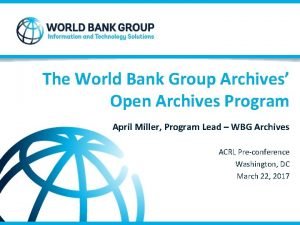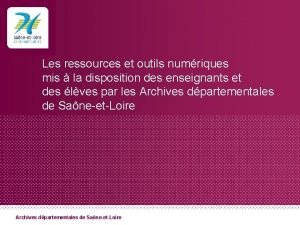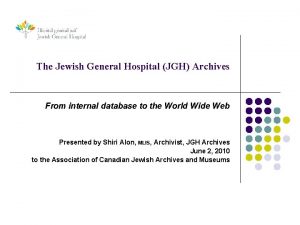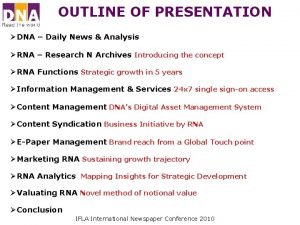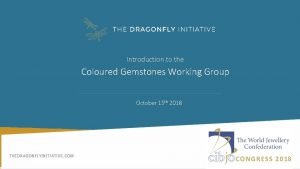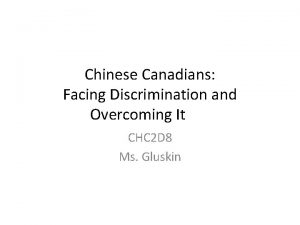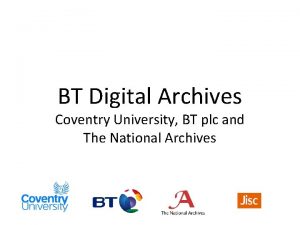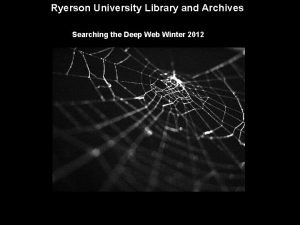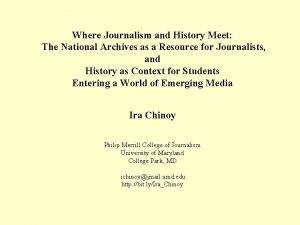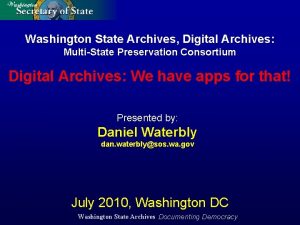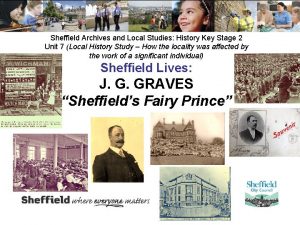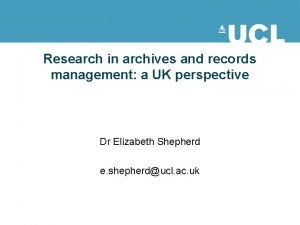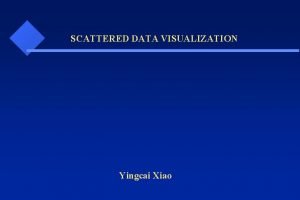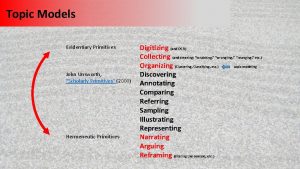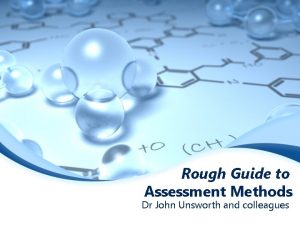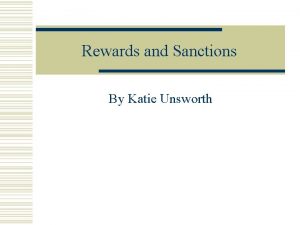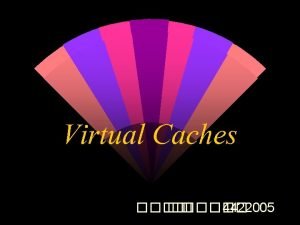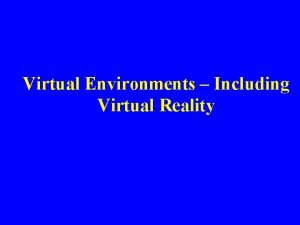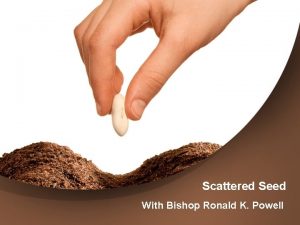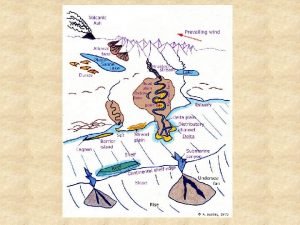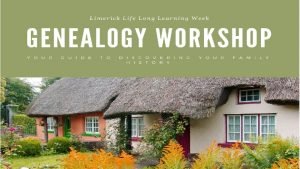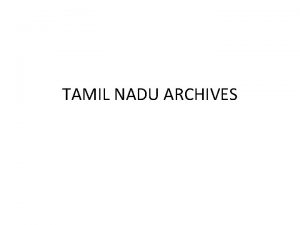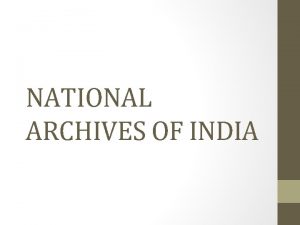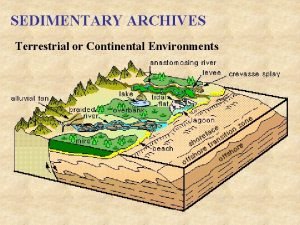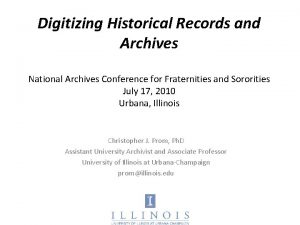The Virtual Reunification of Scattered Archives John Unsworth












































- Slides: 44

The Virtual Reunification of Scattered Archives John Unsworth Dean & Professor Graduate School of Library and Information Science University of Illinois, Urbana-Champaign October 20 th, 2006 British Library

Examples from The Institute for Advanced Technology in the Humanities, University of Virginia: • • The Dante Gabriel Rossetti Archive The Dickinson Electronic Archives The Valley of the Shadow The Walt Whitman Archive The Salem Witch Trials The Piers Plowman Electronic Archive The William Blake Archive • Whitman photo, between 1848 -1854, unknown photographer (perhaps John Plumbe Jr. ), from a lost daugerreotype. • “Look! It is the ghost of Robert Goodell!” illustration of Henry Wadsworth Longfellow, "Giles Corey of Salem Farms, " in. Houghton Mifflin Boston, 1902. Artist John W. Ehninger, 1880, p. 752. • frontispeice from “Mutilations” by Martha Nell Smith, with Jarom Macdonald, designed by Laura Vetter, 2000. • William Blake, Europe, copy E, object 11 (Bentley plate 12), 1794. Lessing J. Rosenwald Collection, Library of Congress. • Piers Plowman, MS R 3. 14 fol 1 v. Trinity College, Cambridge • Frontispeice, “Valley of the Shadow: Two Communities in the Civil War, ” Ed Ayers et al. http: //valley. vcdh. virginia. edu/ • Astarte Syriaca, Alternately titled: Venus Astarte. Dante Gabriel Rossetti, 1876 -1877. Manchester City Art Galleries.

Two very different cases, one American, one British America a Prophecy, copy A, 1795 (The Pierpont Morgan Library): electronic edition object 6 (Bentley 6, Erdman 4, Keynes 4) After the Dazzle of Day (1887? 1888? ) The Charles E. Feinberg Collection of the Papers of Walt Whitman, Library of Congress, Washington, DC.

The William Blake Archive http: //www. blakearchive. org/ America a Prophecy, copy A, object 14 (Bentley 14, Erdman 12, Keynes 12). (Pierpont Morgan Library)

Engravings Burins are held in the palm of the hand (fig. 4) and pushed into the plate and away from the body (fig. 5). To make a curved line, the plate is turned on its leather pad while the burin ploughs straight. Unlike drawing, writing, painting, and etching, engraving is nonautographic and a skill requiring years of training. This is why most painters interested in making prints learned etching, a technique in which one uses a needle like a pen and thus drawing skills already acquired, rather than engraving. Encyclopedie, 1767. Wilson Library, University of North Carolina at Chapel Hill.

Etching William Blake, Illustrations of the Book of Job, 1826, object 6 (Bentley 421. 5) "The Messengers Tell Job of His Misfortunes. ” (Collection of Robert Essick. )

Color Prints William Blake, The Large Color Printed Drawings of 1795 and c. 1805, object 5 (Butlin 294) "God Judging Adam (Tate Collection)"

Sketches William Blake, Sketchbook Containing Drawings for the Engraved Illustrations to the Book of Job, object 17 (Butlin 557. 27) "Study for Plate 11: Job's Evil Dreams” (The Fitzwilliam Museum)

Water Colors William Blake, llustrations to Dante's “Divine Comedy”, object 3 (Butlin 812. 2) "Dante and Virgil Penetrating the Forest, ” Birmingham Museums and Art Gallery.

Illustrations to Milton's “L'Allegro” and “Il Penseroso” and Descriptions of “L'Allegro” and “Il Penseroso” Designs, object 9 (Butlin 543. 5) "The Goblin” (Pierpont Morgan Library)

Manuscript pages Illustrations to Milton's “L'Allegro” and “Il Penseroso” and Descriptions of “L'Allegro” and “Il Penseroso” Designs, object 18 (Bentley 69. 9) "The Spirit of Plato” (Pierpont Morgan Library)

The Order in which the Songs of Innocence & of Experience ought to be paged & placed, object 1 (Bentley 1) "page 1” (Library of Congress)

Scattered Blake Archives 1. The Ashmolean Museum 2. Birmingham Museums & Art Gallery 3. The British Library 4. The British Museum 5. Collection of Robert N. Essick 6. Fogg Art Museum 7. The J. Paul Getty Museum 8. Glasgow University Library 9. The Houghton Library 10. The Henry E. Huntington Library and Art Gallery 11. The Library of Congress 12. Metropolitan Museum of Art 13. Museum of Fine Arts, Boston 14. National Gallery of Art, Washington 15. National Gallery of Victoria, Melbourne 16. The New York Public Library 17. The Pierpont Morgan Library 18. The Royal Institution of Cornwall 19. Tate Collection 20. Victoria and Albert Museum 21. The Whitworth Art Gallery 22. Yale Center for British Art

Why Digitize? The Book of Thel, copy F, 1795, Object 2 and Object 7 (Library of Congress)

Why Transcribe? The Marriage of Heaven and Hell, copy D, object 24 (Bentley 24, Erdman 24, Keynes 24) (Library of Congress)

Why Reunify? William Blake, Songs of Innocence and Experience, copies L (obj. 29, Yale Center for British Art), R (obj. 30, Fitzwilliam Museum), and V (obj. 28, Pierpont Morgan Library)

Unification and Uniformity Images are scanned from three types of source media • 4"x 5" transparencies • 8"x 10" transparencies • 35 mm slides. The transparencies, which include color bars and gray scales to ensure color fidelity, are verified for color accuracy against the original artifact by the photographer and often by an editor as well. Detal from William Blake, The Marriage of Heaven and Hell, copy D, object 10 (Bentley 10, Erdman 10, Keynes 10) (Library of Congress)

Uniform Image Handling Initial scans produce 600 dpi TIFF images, from which are derived 300 dpi TIFFs for color correction. Images less than 40 x 30 cm are scaled 1: 1 against the source dimensions of the original artifact so that on a monitor with 100 dpi screen resolution (or if another screen resolution has been registered in the Image. Sizer applet) they display at true size (plus or minus about 5%) Error in ftp transmission of William Blake, The Marriage of Heaven and Hell, copy D, object 10 (Bentley 10, Erdman 10, Keynes 10) (Library of Congress)

Uniform Image Handling Enlargements of items less than 40 x 30 cm display at three times the size of their original. Images greater than 40 x 30 cm are scaled 1: 2/3 and display smaller than the original but can be shown true size using the Image. Sizer applet on the Object View Page; the enlargements of these larger images are displayed at twice the size of the original. Detail from William Blake, America a Prophecy, copy A, object 10 (Bentley 10, Erdman 8, Keynes 8) (Pierpont Morgan Library)

The BAD • A set of XML tags designed for a specific purpose is known as a Document Type Definition (DTD). • The Blake Archive makes use of several DTDs. • The primary and most expansive of these is known as the Blake Archive Description (BAD). The BAD DTD is used to encode all works at both the object- and the collection-level; its emphasis is on the description of Blake's works as physical artifacts.

The BOD, The TEI • The Archive's second DTD, the Blake Object Description (BOD) is used to encode the textual metadata that constitutes the Image Information record. • The TEI (Text Encoding Initiative) DTD is used for other materials in the archive, such as its bibliographies, collection lists and Erdman's Complete Poetry and Prose of William Blake, where description of the physical artifact is not the DTD's central purpose.

Editorial Goals & Principles The Blake Archive is an extension of ongoing archival, cataloguing, and editorial enterprises into a new medium. Until now there has been no base of knowledge and technology sufficient to conceive, much less execute, an adequate comprehensive edition of the work of this multimedia artist. William Blake, Songs of Innocence and of Experience, copy Z, object 28 (Bentley 28, Erdman 28, Keynes 28) "Frontispiece to Songs of Experience” (Library of Congress)

Mono-media Artist? The dominant tradition of Blake editing has been overwhelmingly literary, partly because of what one of Blake's first critics, the poet Swinburne, called "hard necessity"--the technological and economic obstructions that have prevented the reproduction of accurate images in printed editions. William Blake, The Marriage of Heaven and Hell, copy D, object 10 (Bentley 10, Erdman 10, Keynes 10) (Library of Congress)

Artist or Writer? “On the art-historical flank a productive scholarly tradition of cataloguing has been complementary to but largely disconnected from its editorial counterpart on the literary flank. Consequently, many students and even professional scholars know either the textual or visual side of Blake's work but not both, despite their interconnections at the source. ” http: //www. blakearchive. org/blake/public/about/principles/index. html Detail from William Blake, Milton a Poem, copy C, object 9 (Bentley 8, Erdman not numbered, Keynes 8) (New York Public Library)

Multimedia Editions of Multimedia Objects William Blake, Songs of Innocence and of Experience, copy R, object 11 (Bentley 11, Erdman 11, Keynes 11) "The Blossom” (The Fitzwilliam Museum)

As of 11 October 2006 The William Blake Archive now contains fully searchable and scalable electronic editions of 55 copies of Blake's 19 illuminated books in the context of full bibliographic information about each work, careful diplomatic transcriptions of all texts, detailed descriptions of all images, and extensive bibliographies. In addition to illuminated books, the Archive contains many important series of engravings, sketches, and watercolor drawings, including Illustrations to Thomas Gray's Poems, Water Color and Engraved Illustrations to Dante's Divine Comedy, The Large Color Printed Drawings of 1795 and c. 1805, and the recently published Linnell set of Book of Job water colors and the Sketchbook Containing Drawings for the Engraved Illustrations to the Book of Job.

The Walt Whitman Archive http: //www. whitmanarchive. org/ Frank Pearsall, photographer, 1869 (Library of Congress) "Song of the Universal" Item 6, Yale Collection of American Literature, Beinecke Rare Book and Manuscript Library. Leaves of Grass, 1855

Whitman Manuscripts • • • Manuscript Poems Manuscript Prose Proofs & Galleys Monographs & Edited Collections Poems Set to Music Fragments Notes Clippings Correspondence Drawings Photographs Memorabilia Photo of Whitman in his bedroom, 1891, taken by Dr. William Reeder, Philadelphia (Library of Congress)

Whitman’s Poetry Manuscripts “Much of the work of the Whitman Archive is currently focused on editing of his poetry manuscripts, crucial documents that have never before been systematically collected, transcribed, and presented. We have chosen to define ‘poetry manuscript’ broadly, since it is often hard to determine the boundary between prose and verse in Whitman's manuscripts—especially in the pre-war years, Whitman habitually migrated his writing from prose to verse. For the purposes of this project, we consider as a poetry manuscript any writing in Whitman's hand that either is written as verse, contains a key image or language that eventually made its way into a recognized Whitman poem, or discusses the making of a poem. ”

Scattered Whitman Archives 1. American Antiquarian Society 2. Amherst College Archives and Special Collections 3. Boston Public Library. Walt Whitman Collection 4. Boston University. From the Alice and Rollo G. Silver Collection in the Special Collections 5. Brigham Young University. L. Tom Perry Special Collections 6. California, University of, Berkeley. The Bancroft Library, Livezey-Walt Whitman Collection 7. Dartmouth College 8. Duke University, The Trent Collection of Walt Whitman Manuscripts 9. Harry Ransom Humanities Research Center at the University of Texas at Austin. Walt Whitman Collection 10. Harvard University. Manuscripts Department, Houghton Library 11. Haverford College Quaker and Special Collections

Scattered Whitman Archives 12. Johns Hopkins University 13. Huntington Library, Art Collections, and Botanical Gardens 14. Huntington Public Library 15. Library of Congress. John D. Batchelder Collection 16. Library of Congress. Charles N. Elliot Collection 17. Library of Congress. Charles E. Feinberg Collection 18. Library of Congress. Thomas Harned Collection 19. Library of Congress. George S. Hellman Collection 20. Library of Congress. Walt Whitman Collection 21. Manchester University. C. F. Sixsmith Collections of Miscellanea, Printed and Photographic Material, Traubel Correspondence, and Walt Whitman Collection 22. Manchester University. Papers Relating to J. W. Wallace and the Bolton Whitman Fellowship 23. Mills College. Albert M. Bender Collection 24. The Pierpont Morgan Library, New York

Scattered Whitman Archives 25. New York Public Library. Henry W. and Albert A. Berg Collection 26. North Carolina at Chapel Hill, University of 27. Ohio Wesleyan University. The Bayley-Whitman Collection 28. Pennsylvania, University of. Walt Whitman Collection 29. Princeton University 30. Rutgers University 31. South Carolina, University of. Joel Myerson Collection of Nineteenth-Century American Literature 32. Temple University 33. Tulsa, University of 34. Virginia, University of, Papers of Walt Whitman (MSS 3829, 5604), Clifton Waller Barrett Library of American Literature, Albert H. Small Special Collections Library 35. Walt Whitman House in Camden 36. Washington University. George N. Meissner Collection 37. Yale University. Yale Collection of American Literature, Beinecke Rare Book and Manuscript Library

Transcription

Encoding Manuscripts

Scholars and Archivists “From the beginning, the project was conceived as one in which the scholars, archivists, and librarians would work together collaboratively. Each community brings special skills to the development of the online integrated guide. . the archivists on the team noted that special funding is typically required to provide item-level descriptions or calendar-level information, and that such information is not usually needed by most users. [However, ] a national icon like Whitman may require item-level descriptions, whereas other collections may not merit the staff time. In such instances, the collaboration between scholars and archivists can be very valuable. ”

“Disrespecting Original Order” * “The wide dispersion of Whitman's manuscripts throughout his lifetime and after his death makes it impossible to determine an original order. . In the case of Whitman's manuscripts, the research group concluded that scholars would be best served by creating a single, integrated guide to Whitman's poetry manuscripts [which] would display the images of the poetry manuscripts (work by the author) with enhanced descriptions (work by librarians or archivists and scholars), and a citation and link to the individual holding institution's finding aid (work by archivists). ” * Frank Boles, "Disrespecting original order", The American Archivist, Vol. 45 No. 1, pp. 26 -32.

Deathbed Order The first attempt to generate the integrated union finding aid was exciting. . . but grouping the poetry drafts was impossible without some means of identifying like drafts. Whitman was amazingly prolific, and he did not consistently name his poetry drafts in ways that logically or meaningfully grouped the drafts. [Therefore, project members] developed a system of identification which embeds in the union finding aid relationships between manuscripts of Whitman poems and the conceptual “work” they contribute to. The title of the “work” is derived from the final manifestation of the poem, most often the version Whitman published in his final, or “deathbed, ” edition of Leaves of Grass (1892).

Cooperative Encoding “Planning how to unite the finding aids for poetry manuscripts described in over 30 finding aids at 29 repositories (some repositories have more than one Whitman collection) has offered some interesting challenges. ” (Kay Walter and Ken Price. “An Online Guide to Walt Whitman’s Dispersed Manuscripts. ” Library Hi Tech. Volume 22 Number 3, 2004. 277 -282. )

Large Scale Virtual Reunification through an Integrated Finding Aid

Man(uscripts) United

Why? “Our aim is to produce a scholarly edition of Whitman on the web. We're doingofthis in part because his work The dominant tradition Blake editing has been defies the constraints of the book. Whitman's work overwhelmingly literary, partly because of what one of was always incalled flux, and Blake's first being critics, revised, the poetwas Swinburne, "hard fixed forms of print do not adequately capture his necessity"--the technological and economic incessant revisions. Moreover, thethe economics of print obstructions that have prevented reproduction of publication have led previous editors to privilege one accurate images in printed editions. edition or another of Whitman's writings—usually the first or last version of Leaves of Grass. ”

Larger Context?

And that context, in the future, includes the archives of “Archives” such as these:

unsworth@uiuc. edu
 Lesson 2 the reunification of japan
Lesson 2 the reunification of japan Drrm family reunification plan
Drrm family reunification plan Raptor emergency management
Raptor emergency management Gillian unsworth
Gillian unsworth Gillian unsworth
Gillian unsworth Dr susanna unsworth
Dr susanna unsworth Back scattered electrons
Back scattered electrons Scattered fibroglandular
Scattered fibroglandular Cykf metar
Cykf metar Bread that was sown
Bread that was sown Scattered white matter lesions
Scattered white matter lesions Nebulous farm village type
Nebulous farm village type Chapter 6 biomes section 1 what is a biome
Chapter 6 biomes section 1 what is a biome Justice involved supportive housing
Justice involved supportive housing Broken vessels joel houston
Broken vessels joel houston Wisconcin digital archives
Wisconcin digital archives National archives gb rail 253/516
National archives gb rail 253/516 Archives and museums du study material
Archives and museums du study material Write a brief note on the national archives of india.
Write a brief note on the national archives of india. National archives and records service
National archives and records service Baltimore city archives
Baltimore city archives Religious archives examples
Religious archives examples Vanderbilt tv news archive
Vanderbilt tv news archive Indot rfp
Indot rfp Motherwell times archives
Motherwell times archives Edhint
Edhint The world bank
The world bank Interim archives
Interim archives Www.archives.71fr
Www.archives.71fr Jewish general hospital archives
Jewish general hospital archives Dna mumbai epaper
Dna mumbai epaper Coloured gemstones working group
Coloured gemstones working group Library and archives canada
Library and archives canada Bt digital archives
Bt digital archives Ryerson library and archives
Ryerson library and archives National archives
National archives Washington digital archives
Washington digital archives Sheffield local studies library
Sheffield local studies library Ucl archives and records management
Ucl archives and records management Has virtual functions and accessible non-virtual destructor
Has virtual functions and accessible non-virtual destructor Hình ảnh bộ gõ cơ thể búng tay
Hình ảnh bộ gõ cơ thể búng tay Frameset trong html5
Frameset trong html5 Bổ thể
Bổ thể Tỉ lệ cơ thể trẻ em
Tỉ lệ cơ thể trẻ em Voi kéo gỗ như thế nào
Voi kéo gỗ như thế nào
